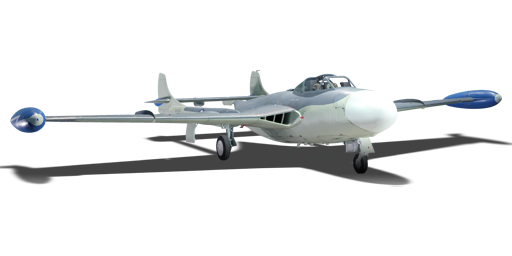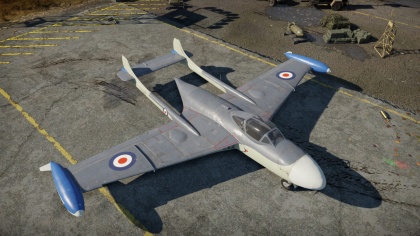Sea Venom FAW 20
Contents
| This page is about the British jet fighter Sea Venom FAW 20. For the standard version, see Venom FB.4. |
Description
The Sea Venom FAW 20 is a rank V British naval jet fighter
with a battle rating of 8.0 (AB/SB) and 7.7 (RB). It was introduced in Update 1.57 "Battle March".
The Sea Venom FAW.20 is a carrier-based jet fighter located in the British naval line after the Sea Hawk FGA.6. The Sea Venom has very good diving characteristics, good roll rate making it a notable defensive flyer, and decent speed characteristics for a jet of its battle rating. It should be played as a Boom & Zoom aircraft, and it's very important to keep its speed up as the acceleration is somewhat lacklustre.
General info
Flight performance
The Sea Venom is a relatively light jet but heavy compared to other planes it will face, specially prop planes. Despite the high agility of the venom compared to other jet, it is really mediocre agaisnt prop planes as most of them will outturn you within seconds. It maintains energy much better than it is to turn, meaning the Sea Venom should be flown as a Boom and Zoom plane rather than a turn fighter. Its acceleration is impressive compared to other jets and almost superb to even prop planes. It should be noted that the venom will lose a tremendous amount of energy when trying to turn fight a plane. Fighting at sea level is the way to go of this plane as only couple planes, like the MiG-15 will be able to catch you up. Be aware of jets like Sea Hawk Mk.100 as they have anti air missiles which will catch you up.
| Characteristics | Max Speed (km/h at 3,048 m) |
Max altitude (metres) |
Turn time (seconds) |
Rate of climb (metres/second) |
Take-off run (metres) | |||
|---|---|---|---|---|---|---|---|---|
| AB | RB | AB | RB | AB | RB | |||
| Stock | 935 | 908 | 12192 | 26.1 | 26.8 | 22.9 | 21.5 | 850 |
| Upgraded | 1,033 | 985 | 24.2 | 25.0 | 33.5 | 28.0 | ||
Details
| Features | |||||
|---|---|---|---|---|---|
| Combat flaps | Take-off flaps | Landing flaps | Air brakes | Arrestor gear | Drogue chute |
| ✓ | ✓ | ✓ | ✓ | ✓ | X |
| Limits | ||||||
|---|---|---|---|---|---|---|
| Wings (km/h) | Gear (km/h) | Flaps (km/h) | Max Static G | |||
| Combat | Take-off | Landing | + | - | ||
| 0 | 420 | 450 | 351 | 320 | ~13 | ~6 |
| Optimal velocities (km/h) | |||
|---|---|---|---|
| Ailerons | Rudder | Elevators | Radiator |
| < 650 | < 640 | < 640 | N/A |
Engine performance
| Engine | Aircraft mass | ||||||
|---|---|---|---|---|---|---|---|
| Engine name | Number | Empty mass | Wing loading (full fuel) | ||||
| de Havilland Ghost-103 | 1 | 4,520 kg | 239 kg/m2 | ||||
| Engine characteristics | Mass with fuel (no weapons load) | Max Takeoff Weight | |||||
| Weight (each) | Type | 10m fuel | 20m fuel | 30m fuel | 33m fuel | ||
| 1,000 kg | Centrifugal-flow turbojet | 5,036 kg | 5,545 kg | 6,054 kg | 6,207 kg | 7,080 kg | |
| Maximum engine thrust @ 0 m (RB / SB) | Thrust to weight ratio @ 0 m (100%) | ||||||
| Condition | 100% | WEP | 10m fuel | 20m fuel | 30m fuel | 33m fuel | MTOW |
| Stationary | 2,100 kgf | N/A | 0.42 | 0.39 | 0.37 | 0.34 | 0.30 |
| Optimal | 2,100 kgf (0 km/h) |
N/A | 0.42 | 0.39 | 0.37 | 0.34 | 0.30 |
Survivability and armour
- 3 mm Steel plate under the jet engine.
Armaments
Offensive armament
The Sea Venom FAW 20 is armed with:
- 4 x 20 mm Hispano Mk.V cannons, nose-mounted (150 rpg = 600 total)
Usage in battles
The Sea Venom has a fully air fighting role as the lack of ordnance and penetration for the 20 mm cannons make the aircraft useless for CAS or ground attack. The Sea Venom has 2 primary combat roles, as well as 1 last resort:
Bomber hunter:
The radar, speed, acceleration, and firepower make this jet usable for bomber hunting, especially when on cloudy maps as many planes at the BR lack radar. Pilots should use 30° climb to gain speed and altitude to be able to hunt bombers (always use aircraft carrier takeoff when possible). Depending on the type of bomber that the Sea Venom encounters (jet bomber or prop bomber), tactics should vary.
For jet bombers:
Ar 234 B-2, Ar 234 C-3, IL-28 (all variants), etc, the pilot must try to use their agility to their advantage as most of them carry both offensive and defensive weaponry and sometimes will try to dogfight you (with exception of Ar 234 B-2 and B-57A). IL-28 should be aproached carefully as the 23 mm offensive and defensive cannons can tear the Sea Venom apart with small bursts. Use your speed to your advantage.
For prop bombers:
B-29/Tu-4, etc, the pilot must use boom and zoom tactics as big planes lack agility but have powerful firepower. These aircraft should be approached as any other prop bomber (head-on or from below). Be aware of B-29 and Tu-4 as both have ventral turrets that will harm you, approach them in a head-on or in a frontal arc of 45° (blind spot for most turrets) or in a very steep angle from above (although this should not be the main angle of approach as both B-29 and Tu-4 have a turret elevation of 89°).
Air superiority fighter:
The Sea Venom is one of the fastest jets at its BR (909 km/h at sea level with no upgrades) and will outrun most planes when energy is kept. Do not attempt to turn fight as you will lose a tremendous amount of energy and most planes will outturn you (Ho 229, Kikka, etc). Boom and zoom and do not be afraid of running, most planes will not be able to chase you. Do not attempt to outrun enemy jets when uptiered as aircraft like MiG-15 will catch you easily.
Bait':
This tactic should be a last resort when you are unable to take down any aircraft. The Sea Venom is a pretty easy target due to its small and tight cabin and small wingspan (although this can sometimes be beneficial) but can be used as bait for enemy planes for the same reason. Let friendlies deal with them while you grab their attention.
Radars
The sea venom is equipped with an AI Mk. X search radar, located in the nose of the aircraft.
| AI Mk. X | |||
|---|---|---|---|
| Target Detection Radar | |||
| Maximum Detection Range |
Guaranteed Detection Range |
Max Azimuth Scan Angle |
Max Elevation Scan Angle |
| 14,000 m | 8,500 m | ±75° | -20°/+40° |
Modules
| Tier | Flight performance | Survivability | Weaponry | ||
|---|---|---|---|---|---|
| I | Fuselage repair | Offensive 20 mm | |||
| II | New boosters | Compressor | Airframe | ||
| III | Wings repair | Engine | New 20 mm cannons | ||
| IV | G-suit | Cover | |||
- The engine is somewhat underpowered, so it is recommended to research compressor and engine modifications first for better acceleration and top speed.
Pros and cons
Pros:
- Adequate ammo supply of 600 rounds (150 RPG)
- Able to land on carriers in case an airfield is not available
- Able to take off from carriers, allowing acceleration from 0 to 300 km/h in couple seconds
- Good turn time and roll rate
- Good at defensive flying
- Very good at diving with a high rip speed of 1,040 km/h IAS
- Retains energy well
- Low compression at high speeds
- Faster than most aircraft it faces when down-tiered
- Has access to a search radar (max range 18 km, fast sweep)
Cons:
- G-LOCs easily
- Does not prepare you well for top rank combat (for new top tier pilots in air realistic battles)
- No payload (for tank realistic battles)
- Subpar acceleration
- Rudder effectiveness is inadequate, due to small size
History
Describe the history of the creation and combat usage of the aircraft in more detail than in the introduction. If the historical reference turns out to be too long, take it to a separate article, taking a link to the article about the vehicle and adding a block "/History" (example: https://wiki.warthunder.com/(Vehicle-name)/History) and add a link to it here using the main template. Be sure to reference text and sources by using <ref></ref>, as well as adding them at the end of the article with <references />. This section may also include the vehicle's dev blog entry (if applicable) and the in-game encyclopedia description (under === In-game description ===, also if applicable).
Media
Excellent additions to the article would be video guides, screenshots from the game, and photos.
See also
Links to the articles on the War Thunder Wiki that you think will be useful for the reader, for example:
- reference to the series of the aircraft;
- links to approximate analogues of other nations and research trees.
External links
Paste links to sources and external resources, such as:
- topic on the official game forum;
- encyclopedia page on the aircraft;
- other literature.
| De Havilland Aircraft Company Limited | |
|---|---|
| Fighters | Hornet Mk.I · Hornet Mk.III · Mosquito FB Mk VI · Mosquito FB Mk XVIII |
| Jet fighters | Vampire F.B.5 · Venom FB.4 · Sea Venom FAW 20 · Sea Vixen F.A.W. Mk.2 |
| Export | ␗Mosquito FB.Mk.26 · ▄Vampire FB 52A(Italy) · ▄Vampire FB 52A(Finland) · A28B |
| Britain jet aircraft | |
|---|---|
| Blackburn | Buccaneer S.1 · Buccaneer S.2 · Buccaneer S.2B |
| British Aerospace | Harrier GR.7 · Sea Harrier FRS.1 (e) · Sea Harrier FRS.1 · Sea Harrier FA 2 |
| British Aircraft Corporation | Strikemaster Mk.88 |
| English Electric | Canberra B Mk 2 · Canberra B (I) Mk 6 · Lightning F.6 · Lightning F.53 |
| Gloster | Meteor F Mk 3 · Sea Meteor F Mk 3 · Meteor F Mk 4 G.41F · Meteor F Mk 4 G.41G · Meteor F Mk 8 G.41K · Meteor F Mk.8 Reaper |
| Javelin F.(A.W.) Mk.9 | |
| de Havilland | Vampire F.B.5 · Venom FB.4 · Sea Venom FAW 20 · Sea Vixen F.A.W. Mk.2 |
| Hawker | Sea Hawk FGA.6 · Hunter F.1 · Hunter F.6 · Hunter FGA.9 · Harrier GR.1 · Harrier GR.3 |
| Panavia | Tornado GR.1 · Tornado GR.4 · Tornado F.3 · Tornado F.3 Late |
| SEPECAT | Jaguar GR.1 · Jaguar GR.1A · Jaguar IS |
| Supermarine | Attacker FB 1 · Attacker FB.2 · Scimitar F Mk.1 · Swift F.1 · Swift F.7 |
| Foreign | Phantom FG.1 (USA) · Phantom FGR.2 (USA) · F-4J(UK) Phantom II (USA) |
| Australia | F-111C |
| India | ▄MiG-21 Bison |
| South Africa | ▄JAS39C |





